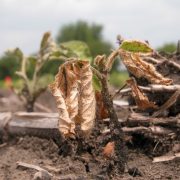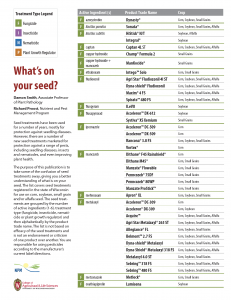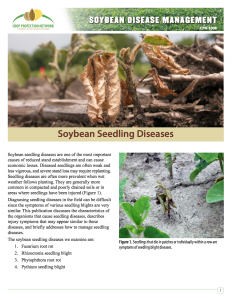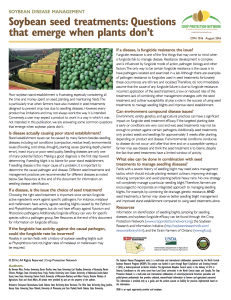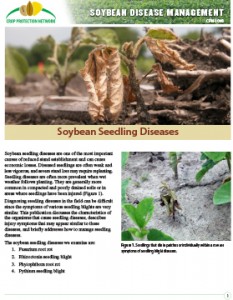I Finally Got My Soybeans Planted and Now They Look Sick!
Damon Smith, Extension Field Crops Pathologist, Department of Plant Pathology, University of Wisconsin-Madison
Shawn Conley, Soybean and Wheat Extension Specialist, Department of Agronomy, University of Wisconsin-Madison
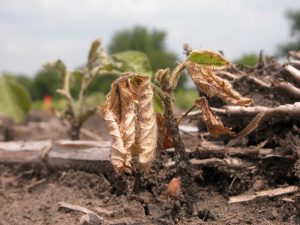
Phytophthora stem rot of a seedling soybean. Photo Credit: Craig Grau.
The 2019 growing season has been nothing but full of challenges for Wisconsin farmers and farmers throughout the Midwest. Weather and grain markets have not improved, combined with late-planting of all crops, including soybeans. Dryer weather recently has allowed many to catch up a bit on planting, but now the weather is turning wet again. With this wet weather right after planting, we start to get concerned about several seedling and early-season diseases that can show up, and the performance of seed treatments used to protect soybeans against the pathogens that cause these diseases.
What are the Pathogens of Primary Concern?
Soybeans are susceptible to several early diseases. A detailed list of those important in Wisconsin can be found HERE. You will notice in that list that there is an array of fungi and water-molds that can affect soybeans, compromising stands. More recently we have been very interested in tracking the water-molds. These organisms include Pythium and Phytophthora. Pythium can cause diseases such as Pythium seedling blight and root rot while Phytophthora can result in Phytophthora root and stem rot of soybean. When it comes to both of these diseases, several species within each pathogen genus can affect soybeans in Wisconsin. In fact, The Wisconsin Department of Agriculture, Trade and Consumer Protection Pest Survey Program and the Plant Industry Bureau Laboratory has tracked water-molds in soybean fields from since 2008. The latest results of this surveys can be found by CLICKING HERE. You will notice that there are actually two Phytophthora species and more than 5 Pythium species that can affect soybeans in Wisconsin. With the diversity of pathogens in the state and the wet spring we are having, it is no wonder that seedling issues are present in Wisconsin.
Will Seed Treatments Cure Poor Soybean Emergence?
The short answer is no. In the last 10 years we have seen a significant increase in the availability and use of seed treatments in soybeans. These seed treatments can be a simple single-mode-of-action fungicide or combined with multiple fungicides, insecticides, nematicides, and/or plant growth regulators. A detailed list of seed treatment products registered in Wisconsin for soybeans and other grain crops can be found on the What’s On Your Seed fact sheet. While we highly recommend the use of seed treatments to combat seed rots and seedling blights, it is important to realize that they are not perfect and can fail or under-perform for many reasons. Even if you used a seed treatment on your soybean seed in 2019, you may still notice emergence issues. There are many factors that play a role in the success of a seed treatment, including the correct choice of product against the right pathogens, weather, soil type, etc. For more information on the factors that can affect seed treatments check out the fact sheet posted HERE. If you are in a situation where you used a seed treatment and the stand is poor, check out this publication. This can give you some insight on what happened as you work through diagnosing the issue with your agronomist. There is not a one-size-fits-all seed treatment so it is important that if you have had issues with the performance of your seed treatment, you determine if a pathogen is involved and what species it might be. Knowing this information can help guide you in choosing the seed treatment most appropriate for controlling that particular pathogen in the future. If you need help diagnosing a potential seed decay or seedling disease, you can send a sample to the University of Wisconsin-Madison Plant Disease Diagnostic Clinic. Details on how to prepare and send a sample can be found on their website by clicking here.
Does Variety Resistance Help Improve Soybean Stands?
Yes! While resistance to Pythium in soybean isn’t well understood, there are resistant varieties deployed for managing Phytophthora. Both race-specific and field resistance (lower level of resistance to all races) are available in soybean varieties marketed in Wisconsin. There are often one or more race-specific Phytophthora resistance genes in commercial soybean varieties. The genes present in specific soybean varieties are listed each year in the University of Wisconsin Soybean Variety Test Results (UW-Extension publication A3654). Your seed dealer will also have this information.
Monitor the performance of the varieties you choose. When optimum disease conditions develop later in the growing season, scout those areas of the fields to look for stem rot development. If a large number of plants with Phytophthora stem rot are found, choose varieties with a different Rps gene and higher levels of partial resistance for next year. This pathogen does adapt to the Rps genes, but it is a slow process. Careful monitoring of plant performance is all that is needed. A listing of RPS genes and their relative effectiveness in Wisconsin can be found in the table below.
Race-specific Phytophthora resistance genes and their effectiveness in Wisconsin
| Soybean genes | Phytophthora races controlled | Effectiveness in Wisconsin |
| Rps 1a | 1, 2, 10, 11, 13-18, 24 | limited effectiveness |
| Rps1b | 1, 3-9, 13-15, 17, 18, 21, 22 | |
| Rps 1c | 1-3, 6-11, 13, 15, 17, 21, 23, 24 | effective in 75% of fields |
| Rps 1k | 1-11, 13-15, 17, 18, 22, 24 | effective in 99% of fields |
| Rps 3 | 1-5, 8, 9, 11, 13, 14, 16, 18, 23, 25 | |
| Rps 4 | 1-4, 10, 12, 16, 18-21, 25 | |
| Rps 6 | 1-4, 10, 12, 14-16, 18-21, 25 | |
| Rps 1k, 6 | 1-11, 12-22, 24, 25 |
Field resistance, also called field tolerance, is present at different levels in most soybean varieties marketed in Wisconsin. For example, even if a variety has a specific resistance gene that may not be effective, such as Rps 1a, against the races of Phytophthora sojae present in a field, the variety may perform better than other varieties with this gene because it has an adequate level of field resistance to Phytophthora. Field resistance can be overcome by high disease pressure especially in the seedling stage. A final note on resistance – in field where Phytophthora sansomeana is present, Rps genes may have little effect. No data currently exists on soybean variety performance against this fairly new pathogen of soybean in Wisconsin.

